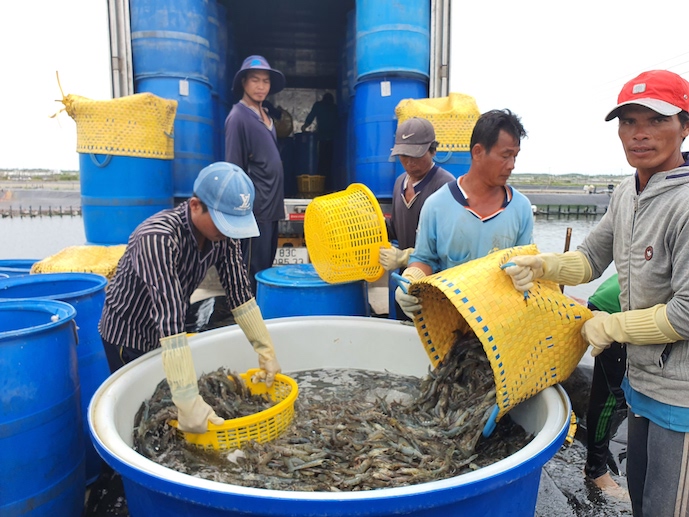Vietnam races to boost shrimp exports ahead of U.S. tariffs, explores new markets
As of the end of April 2025, Vietnam’s shrimp exports reached over USD 1.3 billion, a 34% increase compared to the same period last year. The looming threat of retaliatory tariffs from the U.S. also led exporters to accelerate shipments, taking advantage of a temporary tariff suspension.
Markets like Japan, the EU, South Korea, Australia, the UK, Taiwan, and Switzerland all posted notable gains, indicating a strategic shift as Vietnamese firms diversify away from overdependence on the U.S. amid rising trade tensions.

China: A high-potential market with short-term volatility
With USD 389 million in shipments (up 103%) in the first four months, China and Hong Kong have become Vietnam’s largest shrimp market, accounting for nearly 30% of total exports. The surge was largely due to robust demand for lobster.
China’s newly announced 2025–2030 nutrition guidelines prioritize high-protein foods, especially fish and seafood, including their integration into school meal programs. This policy shift could spur long-term demand for mid-range seafood like pangasius and small-to-medium shrimp.
In 2023, China imported a record 4.67 million tons of seafood, and it maintained a high level of 4.5 million tons in 2024. For shrimp alone, China was the world’s top importer, buying over 1.1 million tons in 2023 and more than 1 million tons in 2024.
In the short term, however, demand for warmwater frozen shrimp in China has softened. April 2025 imports reached 70,067 tons (USD 356 million), a 5% increase in volume and 6% in value year-on-year. Cumulatively, the first four months saw 269,689 tons worth USD 1.45 billion, down 9% in volume but up 1% in value, with average prices rising 11% to USD 5.36/kg.
This slowdown is attributed to China’s sluggish economy, rising domestic shrimp production, and stiff competition from other popular seafood. Chinese consumer sentiment also remains unstable under broader macroeconomic pressure.
United States: A tariff-driven boost, but uncertainty remains
Shrimp exports to the U.S. totaled USD 193 million in the first four months of 2025, up 15%. April alone saw a 25% spike, driven by exporters rushing to deliver goods ahead of potential tariff changes.
However, the outlook is unclear as the U.S. finalizes its retaliatory tariff strategy. Exporters are prioritizing pre-contracted orders, with some awaiting further clarity and others including conditional clauses in new contracts.
Several scenarios have been floated, with concerns that Vietnam’s 46% countervailing tariff rate could leave it at a disadvantage compared to competitors like Bangladesh (37%), Thailand (36%), India (26%), and Ecuador (10%). If finalized, these rates could significantly undermine Vietnam’s share in the U.S. market.
Still, hopes remain that ongoing Vietnam–U.S. negotiations will yield favorable outcomes. Vietnam continues to address key U.S. trade concerns, including lowering barriers to American goods, improving origin fraud prevention, flexible exchange rate management, and protecting intellectual property.
EU: A steady anchor market
The EU remains a crucial market amid U.S. turbulence, with exports rising 28% to USD 152 million (11.7% of total volume). The region’s stability is partly due to consistent home consumption patterns, less sensitive to restaurant trends or price fluctuations.
Vietnamese firms promoted their products at the Seafood Expo Global in Barcelona in May, with VASEP and 28 companies participating. The event highlighted Vietnam’s push to diversify and reduce dependency on high-barrier markets.
Japan: A traditional market needing fresh strategies
Japan imported USD 169 million worth of Vietnamese shrimp in the first four months, up 20%. While the market is longstanding, competition is intensifying. Japanese consumers value quality and consistency, prompting calls for Vietnamese exporters to invest more in deep processing, product customization for Japanese tastes, and brand communication.
Strategy shifts for long-term resilience
Despite a promising start to 2025, the outlook for shrimp exports remains uncertain. Firms are urged to restructure their market approach, focusing on diversification, value-added products, and tapping into FTA benefits like EVFTA, CPTPP, and RCEP to grow exports to the EU, Japan, and South Korea.
New markets in the Middle East and Latin America also offer opportunities to reduce concentration risk. The domestic market should not be overlooked.
Exporters might also learn from Ecuador’s vertically integrated model, which has strengthened its competitiveness. Ecuadorian firms are acquiring shrimp farms, investing in processing tech, and building a strong global brand.
Vietnam’s shrimp sector must adapt quickly to maintain its edge amid global trade headwinds.
VFM






